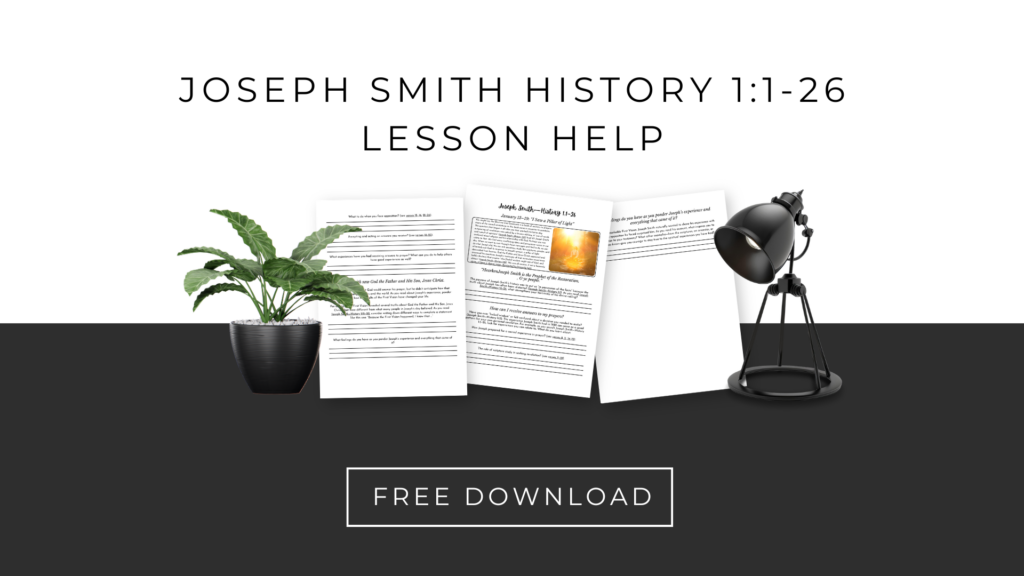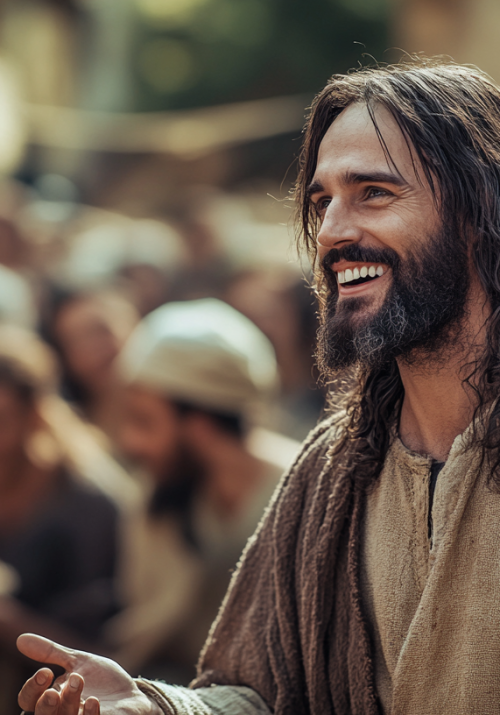
In this article, weʻll be deep diving into Joseph Smith – History 1:1-26. To download our free lesson help + customizable Canva Template, click here: https://otherthanamom.myflodesk.com/jsh1-1-26

Joseph Smith is the Prophet of the Restoration.
Engaging Questions:
- What details in Joseph Smith’s account (Joseph Smith—History 1:1–26) strengthen your testimony of his divine calling as a prophet?
- How do Joseph’s experiences as a young seeker of truth inspire you to seek answers to your own questions about God and faith?
- What do you learn from Joseph Smith’s determination to remain true to his experience despite opposition and ridicule?
- If you were to explain to a friend why you believe Joseph Smith is a prophet, which part of his history would you share and why?
- What role does the First Vision play in your understanding of the Restoration of the gospel?
- How does Joseph Smith’s humble background emphasize the Lord’s ability to use ordinary people for extraordinary purposes?
- What connections do you see between Joseph Smith’s experiences and your own efforts to seek truth and guidance from God?
- What can you do to deepen your testimony of Joseph Smith as a prophet of the Restoration?
- How does understanding Joseph Smith’s trials and perseverance help you face challenges in standing up for your own beliefs?
- What evidence do you see in your life, Church history, or the world today that confirms Joseph Smith’s divine calling as a prophet?
Object Lessons:
1. The Small Candle (Light in the Darkness)
Materials Needed: A small candle and matches or a flashlight.
Turn off the lights and light the candle, explaining how Joseph Smith’s First Vision brought light and truth into a spiritually darkened world. Despite opposition, the light spread, illuminating the way for the Restoration.
Lesson: Like a small candle dispelling darkness, Joseph Smith’s divine calling as a prophet brought spiritual light to the world.
2. The Seed and Tree (Growth from Humble Beginnings)
Materials Needed: A seed and a small potted tree.
Show the seed and discuss how Joseph Smith’s humble beginnings—being a young, uneducated farm boy—were like a small seed. Through divine guidance and effort, the Restoration grew into a worldwide Church, much like a tree from a tiny seed.
Lesson: God uses humble beginnings to accomplish great things, as seen in Joseph Smith’s calling and work.
3. The Magnifying Glass (Seeing Clearly Through Revelation)
Materials Needed: A magnifying glass.
Demonstrate how the magnifying glass helps reveal details that are hard to see with the naked eye. Compare this to how Joseph Smith’s First Vision provided clarity and restored truths that had been lost or misunderstood for centuries.
Lesson: Through Joseph Smith’s divine calling, the Lord restored clarity to the gospel of Jesus Christ.
4. The Puzzle (Restoring Missing Pieces)
Materials Needed: A puzzle with a few key pieces missing.
Show the puzzle and explain how it represents the truths of the gospel. Before the Restoration, key pieces were missing, leaving the picture incomplete. Joseph Smith, through revelation, restored the missing pieces, completing the understanding of God’s plan.
Lesson: Joseph Smith’s calling as a prophet helped restore the fullness of the gospel, completing the picture of God’s truth.
5. The Messenger (Delivering God’s Word)
Materials Needed: An envelope or package.
Hold up the envelope and explain that it contains an important message. Just as Joseph Smith was chosen to deliver God’s message of the Restoration to the world, the envelope is not the focus—it’s the message inside that matters most.
Lesson: Joseph Smith was a chosen instrument to deliver God’s message, bringing the truth of the Restoration to all.
Personal Sharing Prompts:
Think of a time when you felt inadequate or unprepared to fulfill a calling or responsibility. How did the Lord help you succeed despite your feelings of weakness?
Think of a time when you saw someone else accomplish great things in the Lord’s work despite their humble circumstances or abilities. How did their example inspire you?
Think of a time when you felt the Lord magnify your efforts in unexpected ways. How did that experience help you trust that He can work through “the weak and the simple”?
Think of a time when you witnessed someone accept a calling or challenge with faith, even when it seemed beyond their ability. How did their faith and efforts bless others?
Think of a time when you learned that humility and willingness were more important than talent or expertise in serving the Lord. How did that realization affect the way you approach service?
Think of a time when you felt prompted to do something outside your comfort zone for the Lord’s work. How did following that prompting teach you about the Lord’s ability to use His servants?
Think of a time when you felt the Lord guide you in teaching or sharing the gospel. How did that experience reassure you that He can use anyone to further His work?
Think of a time when you faced personal challenges but still found ways to serve others. How did serving during a difficult time help you feel closer to the Savior?
Think of a time when someone told you that your efforts or example made a difference in their life. How did that feedback help you see the Lord’s hand in using “the weak and the simple”?
Think of a time when you relied on prayer or scripture study to prepare for a responsibility in the Lord’s work. How did the Lord help you accomplish more than you thought you could?
How can I receive answers to my prayers?
Engaging Questions:
- How has Joseph Smith’s example of preparing for prayer (verses 8, 11, 14–15) inspired you to approach your own prayers differently?
- What role does scripture study play in seeking personal revelation, as shown in verses 11–12? How can you apply this in your own life?
- Have you ever faced opposition while trying to follow spiritual impressions, like Joseph did in verses 15–16, 21–26? How did you overcome it?
- What does Joseph’s willingness to act on the answer he received (verses 18–25) teach you about responding to personal revelation?
- What experiences have you had where prayer helped you find clarity or answers to important questions in your life?
- How does Joseph’s trust in God’s willingness to answer prayer inspire you to deepen your own trust in Him?
- What truths about God the Father and Jesus Christ do you gain from Joseph Smith’s First Vision (verses 15–20)? How do these truths affect your relationship with Them?
- If you were to finish the sentence, “Because the First Vision happened, I know that …,” what would you say?
- How can you help others understand and experience the power of personal revelation in their own lives?
- What feelings or impressions do you have as you reflect on Joseph Smith’s First Vision and its impact on the world and your life?
Object Lessons:
1. The Seed and Growth (Faith and Prayer)
Materials Needed: A small seed and a pot with soil.
Plant the seed and explain that receiving answers to prayers is like planting and nurturing a seed. Joseph Smith planted his “seed of faith” by asking in prayer. Answers, like growth, may take time and require nurturing through scripture study, obedience, and faith.
Lesson: Answers to prayers often come gradually and require faith, patience, and care to grow into something meaningful.
2. The Flashlight (Illumination Through Revelation)
Materials Needed: A flashlight and batteries.
Demonstrate how the flashlight doesn’t work without batteries. Compare the flashlight to prayer and the batteries to preparation (study, pondering, faith). When Joseph prepared through scripture study and sincere prayer, he received light and truth in response.
Lesson: Prayer illuminates our understanding, but preparation and faith are necessary for the light to shine.
3. The Mirror (Reflecting God’s Guidance)
Materials Needed: A clean mirror and a smudged mirror.
Show the clean mirror and explain that it reflects light clearly, symbolizing a heart prepared through humility, scripture study, and prayer. Show the smudged mirror and explain that distractions, doubt, or sin can cloud our ability to hear and reflect God’s guidance.
Lesson: Preparing our hearts and minds allows us to clearly reflect and receive God’s answers.
4. The Compass (Direction Through Prayer)
Materials Needed: A compass.
Demonstrate how a compass provides direction when used correctly. Discuss how Joseph’s prayer was like using a compass to seek clarity and guidance from God. Through prayer, he aligned himself with God’s direction.
Lesson: Prayer is like a compass that helps us navigate through confusion and find God’s will.
5. The Road Map (Following the Answer)
Materials Needed: A map.
Show the map and explain how it gives clear directions but requires effort to follow. Joseph received specific answers, and he acted on them despite challenges. Share how answers to our prayers may include a “map” from God, requiring us to follow His direction with faith.
Lesson: Receiving answers to prayers often comes with a responsibility to act and move forward, trusting God’s plan.
Personal Sharing Prompts:
- Think of a time when you faced a decision or question that felt overwhelming. How did you prepare yourself to receive an answer through prayer?
- Think of a time when a verse of scripture seemed to speak directly to your heart. How did studying the scriptures guide you toward receiving an answer to your prayer?
- Think of a time when you experienced opposition or doubt while seeking personal revelation. How did you overcome those challenges to receive clarity or peace?
- Think of a time when you received an answer to prayer that surprised you. How did you come to accept and act on that answer, even if it wasn’t what you expected?
- Think of a time when you felt prompted to pray about something you hadn’t considered before. How did that prompting lead to new understanding or guidance?
- Think of a time when you felt an answer to prayer come gradually rather than immediately. How did you learn patience and trust in the Lord’s timing during that experience?
- Think of a time when sharing your testimony or experience with personal revelation helped someone else. How did sharing deepen your own understanding of the Lord’s answers?
- Think of a time when you prayed with real intent, as Joseph Smith did, and received a profound answer. How did that experience strengthen your relationship with Heavenly Father?
- Think of a time when you were inspired by an example of someone else receiving revelation. How did their experience motivate you to seek answers more earnestly?
- Think of a time when you felt an answer to prayer through a quiet feeling of peace or a small, simple thought. How did that teach you about the variety of ways the Lord communicates with His children?
Joseph Smith saw God the Father and His Son, Jesus Christ.
Engaging Questions:
- What stands out to you about Joseph Smith’s description of seeing God the Father and Jesus Christ in Joseph Smith—History 1:15–20?
- How does Joseph Smith’s trust in God’s willingness to answer his prayer inspire you in your own prayers?
- What truths about God the Father and Jesus Christ were revealed through the First Vision, and how have these truths influenced your life?
- How would you complete the statement: “Because the First Vision happened, I know that …”?
- How do you think Joseph Smith’s experience of seeing God and Jesus Christ changed his perspective on life and his purpose?
- What feelings or impressions do you have as you reflect on Joseph Smith’s First Vision and its impact on the Restoration?
- If you could ask Joseph Smith one question about his experience during the First Vision, what would it be and why?
- What role does the First Vision play in strengthening your testimony of God’s love and Jesus Christ’s role as our Savior?
- How would you explain the significance of the First Vision to someone unfamiliar with it? What details would you highlight?
- What can you do to show gratitude for the truths and blessings that came because of the First Vision?
Object Lessons:
1. The Sun and the Mirror (Revealing God’s Nature)
Materials Needed: A small mirror and a picture of the sun.
Hold up the picture of the sun and explain how it represents the glory of God. Use the mirror to reflect light and discuss how Joseph Smith’s First Vision reflected the true nature of God the Father and Jesus Christ to the world, showing they are real, distinct beings with glorified bodies.
Lesson: The First Vision reflected divine truths about the nature of God and Jesus Christ, bringing light to a confused world.
2. The Two Candles (Unity and Distinctiveness)
Materials Needed: Two candles and matches.
Light both candles and explain how they represent God the Father and Jesus Christ. They are two distinct beings, yet united in purpose. Discuss how this truth was revealed during the First Vision and how it clarified the nature of the Godhead.
Lesson: Because of the First Vision, we know that God the Father and Jesus Christ are two distinct beings, united in their love and mission for us.
3. The Curtain and the Open Window (Heaven’s Reality)
Materials Needed: A curtain and an open window or a clear picture frame.
Show the closed curtain and explain that before the First Vision, people’s understanding of heaven was obscured, like looking at a covered window. Open the curtain to reveal the view, symbolizing how Joseph’s experience opened the heavens and revealed the truth about God, Jesus Christ, and their relationship with humanity.
Lesson: The First Vision opened the heavens, confirming that God and Jesus Christ are real, living beings who know and love us.
4. The Compass (True Direction from God)
Materials Needed: A compass.
Demonstrate how a compass always points north, providing clear direction. Explain that the First Vision provided spiritual direction for the world, correcting misunderstandings and revealing truths about God and Jesus Christ that guide us today.
Lesson: Because of the First Vision, we have clear direction about God’s nature, our purpose, and the path back to Him.
5. The Lamp in Darkness (Restored Light of Truth)
Materials Needed: A lamp or flashlight.
Turn on the lamp in a dim room and explain how the First Vision brought light to a world darkened by confusion about God. Just as the lamp reveals what was hidden, the First Vision revealed vital truths about God the Father and His Son, Jesus Christ, and began the Restoration.
Lesson: The First Vision restored light and truth about God to the world, illuminating our understanding of His plan.
Personal Sharing Prompts:
Think of a time when you felt a powerful confirmation that God the Father and Jesus Christ are real and separate beings. How did that experience deepen your faith in the First Vision?
Think of a time when you turned to God in prayer, trusting He would answer you. How has Joseph Smith’s example inspired your approach to seeking answers?
Think of a time when you felt God’s love for you as an individual. How does knowing that Joseph Smith saw the Father and the Son affirm your understanding of Their love for all of us?
Think of a time when you felt prompted to share the truth about the First Vision with someone. How did sharing that testimony affect you and the other person?
Think of a time when you realized the significance of living in a world where the First Vision happened. How does this knowledge change the way you approach your daily life or challenges?
Think of a time when you felt strengthened by the knowledge that God hears and answers prayers. How does the First Vision inspire your confidence in seeking personal revelation?
Think of a time when you felt your testimony of the restored gospel grow. How did reflecting on the First Vision help you understand the importance of the Restoration?
Think of a time when you recognized the difference between the teachings of the restored Church and other teachings about God. How has the First Vision clarified your understanding of Heavenly Father and Jesus Christ?
Think of a time when you felt peace knowing that God is actively involved in His children’s lives. How does the First Vision assure you of His ongoing involvement in your life and the world?
Think of a time when you felt awe or gratitude for Joseph Smith’s courage in sharing his experience of the First Vision. How does his example inspire you to stand firm in your testimony?
I can remain true to what I know, even if others reject me.
Engaging Questions:
- What inspires you most about Joseph Smith’s courage to remain true to his testimony despite facing rejection and ridicule?
- Have you ever felt opposition or skepticism when sharing your beliefs? How did you respond, and what did you learn from the experience?
- What spiritual experiences in your life strengthen your resolve to remain true to your testimony, even when it’s difficult?
- What can we learn from Joseph Smith’s response to rejection that can help us stay strong in our faith today?
- Who are some individuals—whether from the scriptures, history, or your own life—whose examples of faithfulness inspire you to stand firm in your beliefs?
- Why do you think it’s important to share your testimony, even if you know some people might not accept it?
- How does trusting in God’s support, as Joseph Smith did, help you face challenges to your faith?
- What advice would you give to someone who is struggling to stay true to their testimony because of criticism or rejection?
- What role does prayer, scripture study, or seeking the Spirit play in helping you remain steadfast in your testimony?
- How has staying true to what you know blessed your life or the lives of those around you?
Object Lessons:
1. The Compass in a Storm (Staying True Despite Opposition)
Materials Needed: A compass.
Show the compass and explain how it continues to point north, even during a storm or when it is shaken. Compare this to Joseph Smith’s steadfast testimony despite ridicule and persecution. Discuss how we can stay true to our testimony, even when the world tries to shake us.
Lesson: Just as a compass remains steady, we can stay true to what we know is right, regardless of challenges or opposition.
2. The Diamond (Value Despite Pressure)
Materials Needed: A piece of coal and a diamond or a picture of each.
Explain that a diamond forms under extreme pressure, symbolizing how opposition can refine and strengthen our faith and character. Share how Joseph Smith’s faith grew stronger as he remained true to his testimony, even when rejected by others.
Lesson: Staying true to our testimony during trials helps us become stronger and more valuable, like a diamond formed under pressure.
3. The Lighthouse (Guidance Amid Darkness)
Materials Needed: A small lighthouse model or picture.
Explain how a lighthouse remains steady and shines its light even in the darkest, stormiest nights. Compare this to Joseph Smith’s courage in sharing the First Vision despite widespread criticism. Discuss how our testimonies can be a light for others, even when we feel alone or rejected.
Lesson: Like a lighthouse, we can shine brightly and stay true to our testimony, even when faced with opposition or darkness.
4. The Tree and the Wind (Rooted Testimony)
Materials Needed: A small tree or plant.
Show the tree and explain how its roots grow deeper when strong winds blow against it. Compare this to how opposition and challenges can strengthen our testimonies when we stay rooted in truth.
Lesson: Opposition can strengthen us if we remain rooted in what we know to be true, just as the wind strengthens a deeply rooted tree.
5. The Filter (Rejecting Negative Influences)
Materials Needed: A water filter or a picture of one.
Demonstrate or describe how a filter removes impurities from water while allowing clean water to flow through. Compare this to how we can filter out negativity, doubts, or criticism and remain focused on the truths we have received.
Lesson: Just as a filter removes impurities, we can let go of negativity and hold on to what strengthens our testimony.
Personal Sharing Prompts:
- Think of a time when you shared your testimony with someone who didn’t accept or understand it. How did you find the courage to remain true to what you know?
- Think of a time when you felt ridiculed or questioned for your beliefs. How did you respond, and what helped you stand firm in your testimony?
- Think of a time when you faced opposition or criticism for living gospel principles. How did staying true to your faith bring you peace or blessings?
- Think of a time when you were inspired by someone else who stood firm in their testimony despite rejection. How did their example strengthen your resolve to stay true to what you know?
- Think of a time when you felt strengthened by prayer or scripture study after facing opposition for your beliefs. How did the Lord’s guidance help you stay true?
- Think of a time when you felt the Spirit confirm the truth of your testimony during a moment of doubt or trial. How did that experience help you overcome fear of rejection?
- Think of a time when you defended your faith or shared a gospel truth in a challenging situation. How did that act of courage strengthen your own testimony?
- Think of a time when you were tempted to compromise your beliefs to fit in or avoid conflict. How did staying true to your testimony bring lasting blessings or peace?
- Think of a time when you felt inspired by a scripture, story, or hymn that encouraged you to stand firm in your faith. How did that message help you face challenges with confidence?
- Think of a time when you felt alone in your beliefs but knew the Lord was with you. How did His presence help you stay faithful to what you know?



